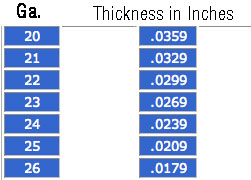The term "gauge" (also spelled gage or ga) refers to the THICKNESS of sheet metal or the DIAMETER measurement of wire. Sheet metal was made using the same standards as wire because People were already familiar with the standard.
There are a number of different gauge standards. In fact, different standards exist for sheet steel, steel strip and tubing, non-ferrous sheet metal (aluminum, brass, copper, etc), stainless steel, and wire. To further compound the issue, within each category mentioned above, there exists American standards, Metric standards as well as several proprietary industry standards.
It is truly safe to say when it comes to any type of gauge standard, there is no standard. When ordering or sizing metal, it is best to get a statement of the actual thickness dimension for the item. Even if you have done your homework and know that a 16 gauge piece if sheet steel (.0598"), a 16 gauge sheet of stainless steel (.0625"), 16 gauge copper wire (.0508") and a 16 gauge tube (.0650") all have different dimensions (as noted), there is no guarantee that the vendor will know the difference as well.
In addition to the image below, an expanded gauge tables for various metals is displayed at:
http://www.corrugated-metals.com/gaugeindecimals.html
An extended discussion of wire gauge with a thickness and physical properties table is located at:
http://en.wikipedia.org/wiki/American_wire auge
auge

Most stove pipe and other metal used in chimney and hearth construction falls within the range shown. For instance, interior black stove pipe it typically 22 or 24 ga. Block-off plates are typically made from 24 or 26 ga. sheet metal.
As you see from the chart, the lower the number (gauge), the thicker the metal.
There are a number of different gauge standards. In fact, different standards exist for sheet steel, steel strip and tubing, non-ferrous sheet metal (aluminum, brass, copper, etc), stainless steel, and wire. To further compound the issue, within each category mentioned above, there exists American standards, Metric standards as well as several proprietary industry standards.
It is truly safe to say when it comes to any type of gauge standard, there is no standard. When ordering or sizing metal, it is best to get a statement of the actual thickness dimension for the item. Even if you have done your homework and know that a 16 gauge piece if sheet steel (.0598"), a 16 gauge sheet of stainless steel (.0625"), 16 gauge copper wire (.0508") and a 16 gauge tube (.0650") all have different dimensions (as noted), there is no guarantee that the vendor will know the difference as well.
In addition to the image below, an expanded gauge tables for various metals is displayed at:
http://www.corrugated-metals.com/gaugeindecimals.html
An extended discussion of wire gauge with a thickness and physical properties table is located at:
http://en.wikipedia.org/wiki/American_wire
 auge
auge
Most stove pipe and other metal used in chimney and hearth construction falls within the range shown. For instance, interior black stove pipe it typically 22 or 24 ga. Block-off plates are typically made from 24 or 26 ga. sheet metal.
As you see from the chart, the lower the number (gauge), the thicker the metal.

